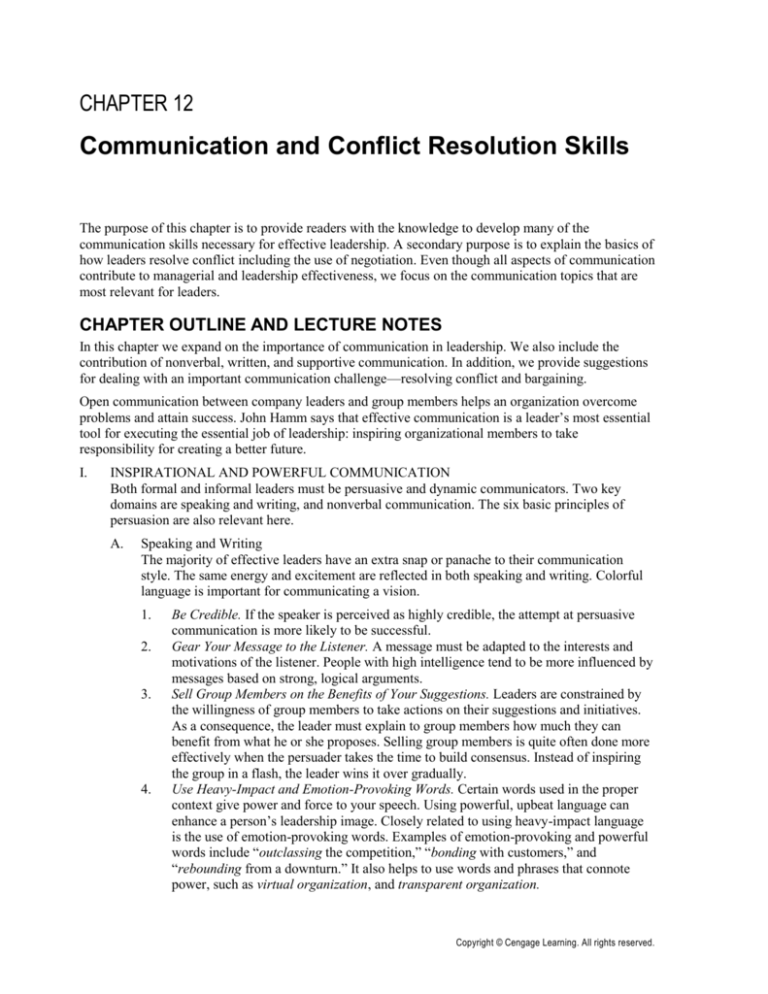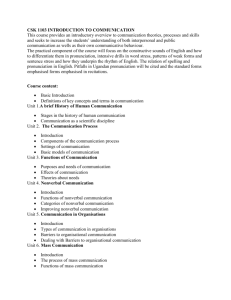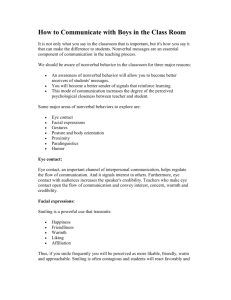
CHAPTER 12
Communication and Conflict Resolution Skills
The purpose of this chapter is to provide readers with the knowledge to develop many of the
communication skills necessary for effective leadership. A secondary purpose is to explain the basics of
how leaders resolve conflict including the use of negotiation. Even though all aspects of communication
contribute to managerial and leadership effectiveness, we focus on the communication topics that are
most relevant for leaders.
CHAPTER OUTLINE AND LECTURE NOTES
In this chapter we expand on the importance of communication in leadership. We also include the
contribution of nonverbal, written, and supportive communication. In addition, we provide suggestions
for dealing with an important communication challenge—resolving conflict and bargaining.
Open communication between company leaders and group members helps an organization overcome
problems and attain success. John Hamm says that effective communication is a leader’s most essential
tool for executing the essential job of leadership: inspiring organizational members to take
responsibility for creating a better future.
I.
INSPIRATIONAL AND POWERFUL COMMUNICATION
Both formal and informal leaders must be persuasive and dynamic communicators. Two key
domains are speaking and writing, and nonverbal communication. The six basic principles of
persuasion are also relevant here.
A.
Speaking and Writing
The majority of effective leaders have an extra snap or panache to their communication
style. The same energy and excitement are reflected in both speaking and writing. Colorful
language is important for communicating a vision.
1.
2.
3.
4.
Be Credible. If the speaker is perceived as highly credible, the attempt at persuasive
communication is more likely to be successful.
Gear Your Message to the Listener. A message must be adapted to the interests and
motivations of the listener. People with high intelligence tend to be more influenced by
messages based on strong, logical arguments.
Sell Group Members on the Benefits of Your Suggestions. Leaders are constrained by
the willingness of group members to take actions on their suggestions and initiatives.
As a consequence, the leader must explain to group members how much they can
benefit from what he or she proposes. Selling group members is quite often done more
effectively when the persuader takes the time to build consensus. Instead of inspiring
the group in a flash, the leader wins it over gradually.
Use Heavy-Impact and Emotion-Provoking Words. Certain words used in the proper
context give power and force to your speech. Using powerful, upbeat language can
enhance a person’s leadership image. Closely related to using heavy-impact language
is the use of emotion-provoking words. Examples of emotion-provoking and powerful
words include “outclassing the competition,” “bonding with customers,” and
“rebounding from a downturn.” It also helps to use words and phrases that connote
power, such as virtual organization, and transparent organization.
Copyright © Cengage Learning. All rights reserved.
Chapter 12: Communication and Conflict Resolution Skills
93
5.
B.
Use Anecdotes to Communicate Meaning. A carefully chosen anecdote is useful in
persuading group members about the importance of organizational values. So long as
the anecdote is not repeated too frequently, it can communicate an important message.
6. Back Up Conclusions with Data. Persuasiveness increases when spoken and written
presentations are supported with solid data. Being too dependent on data, however,
could suggest that you have little faith in your intuition.
7. Minimize Language Errors, Junk Words, and Vocalized Pauses. If you minimize
common language errors you increase persuasiveness and appear more articulate and
informed. An example: “Just between you and I” is wrong. “Just between you and me”
is correct.
8. Use Business Jargon in Appropriate Doses. Sprinkling business talk with jargon helps
establish rapport and adds to a person’s popularity. But too much jargon makes a
person appear stereotyped in thinking, and perhaps even unwilling to express an
original thought—and therefore lacking power.
9. Write Crisp, Clear Memos and Reports, Including a Front-Loaded Message. Business
leaders characteristically write easy-to-read, well-organized messages both in e-mail
and more formal reports. A persuasive speaker or writer places key ideas at the
beginning of a conversation, memo, paragraph, or sentence. Using the active voice
facilitates front-loading messages.
10. Use a Power-Oriented Linguistic Style. A major part of being persuasive involves
choosing the right linguistic style, a person’s characteristic speaking pattern. Several
components of a linguistic style give power and authority to the message sender in
many situations. Several examples follow: (a) downplay uncertainty, (b) use the
pronoun I frequently, (c) apologize infrequently, (d) know exactly what you want, and
(e) frame your comments in a way that increases your listener’s receptivity.
The Six Basic Principles of Persuasion
An advanced method of being persuasive is to capitalize on scientific evidence about how to
persuade people. The six principles listed here have accompanying tactics that can be used to
supplement the other approaches to persuasion described in this chapter.
1.
2.
3.
4.
5.
6.
Liking. People like those who like them.
Reciprocity. People repay in kind. The leader should be a model of desired behavior.
Social proof. People follow the lead of similar others.
Consistency. People align with their clear commitments.
Authority. People defer to experts. Make constituents aware of your expertise.
Scarcity. People want more of what they can have less of. People are more likely to act
if they believe that the resource at issue is shrinking rapidly.
These principles should be applied in combination to multiply their impact.
C.
Nonverbal Communication Including Videoconferencing
Effective leaders are masterful nonverbal and verbal communicators. Nonverbal
communication is important because leadership involves emotion, which cannot be
communicated convincingly enough through words alone. Mentioned here are nonverbal
signals that are likely to connote power, being in control, and forcefulness:
1. Using erect posture when walking, standing, or sitting.
2. Exhibiting dominant behavior, such as standing up straight during confrontation.
3. Smiling frequently, in a relaxed, natural-appearing manner.
4. Gesturing in a relaxed, non-mechanical way.
Clothing, dress, and appearance represent another mode of nonverbal communication. Even
on dress-down days, the majority of effective leaders will choose clothing that gives them an
edge over others. Appearance includes more than the choice of clothing. For example,
Copyright © Cengage Learning. All rights reserved.
94
Chapter 12: Communication and Conflict Resolution Skills
freshly shined shoes and good-looking teeth contribute to a leadership image. What
constitutes a powerful and self-confident image is influenced not only by the organizational
culture but by the culture in general.
A subtle mode of nonverbal communication is the use of time. Guarding time as a precious
resource will help you project an image of self-confidence and leadership.
Videoconferencing places extra demands on the nonverbal communication skills of leaders,
managers, and other participants. Videoconferences are a powerful tool for far-flung
managers to make a name for themselves at corporate headquarters. Also, the camera
multiplies all negative behaviors. Etiquette tips for making a strong nonverbal presence
include the following:
Choose what you wear carefully.
Speak in crisp conversational tones and pay attention.
Behaviors such as rolling eyes to express disagreement show up on the camera.
Avoid culturally insensitive gestures including large hand and body gestures that
make many Asians feel uncomfortable.
Videotape yourself to see what you might look like during a videoconference, and make
necessary adjustments.
II.
LISTENING AS A LEADERSHIP SKILL
Listening is a fundamental management and leadership skill for such purposes as encouraging
subordinates, establishing good exchanges, and identifying problems. Leaders face two major
listening impediments. First, leaders are often overloaded making it difficult to listen. Second,
people listen faster than others speak, which can create mind wandering.
A.
Selective Listening to Problems
Being bombarded with information, the leader makes an intentional or unintentional
decision to listen to just certain problems. Success, however, is dependent on staying open to
all incoming information. The busy leader must avoid listening to limited categories of
information such as good news, bad news, or financial news.
B.
Making the Rounds
Making the rounds refers to the leader casually dropping by constituents to listen to their
accomplishments, concerns, and problems to share information. Through rounding (or
management by walking around) vital information is gathered if the physician or manager
listens carefully. Table 12-2 contains some useful advice on this topic.
III. OVERCOMING CROSS-CULTURAL COMMUNICATION BARRIERS
In today’s workplace, leaders communicate with people from other countries and with a more
diverse group of people from their own country. Implementing the type of guidelines presented
here will assist leaders in overcoming and preventing many communication barriers.
A.
B.
C.
D.
E.
F.
Be sensitive to the fact that cross-cultural communication barriers exist. (Awareness will
lead to asking for feedback.)
Challenge your cultural assumptions. (Assumptions work like stereotypes.)
Show respect for all workers.
Use straightforward language, and speak slowly and clearly.
Look for signs of misunderstanding when your language is not the native language of the
listener.
When the situation is appropriate, speak in the language of the people from another culture.
Copyright © Cengage Learning. All rights reserved.
Chapter 12: Communication and Conflict Resolution Skills
95
G.
Observe cross-cultural differences in etiquette. (For example, in many countries business
people want to dine before conducting business.)
H. Do not be diverted by style, accent, grammar, or personal appearance.
I.
Avoid racial or ethnic identification except when it is essential to communication. Using a
person’s race or ethnicity as an adjective or other descriptor often suggests a negative
stereotype.
J.
Be sensitive to differences in nonverbal communication. (For example, make sure you
understand the acceptability of physical touching.)
K. Be attentive to individual differences in appearance. (Don’t confuse the identity of people
from the same racial or ethnic group.)
IV. THE LEADER’S ROLE IN RESOLVING CONFLICT AND NEGOTIATING
Leaders and managers spend about 20 percent of their time resolving conflicts and negotiating.
Conflict resolution is ordinarily studied in relation to management. We therefore focus on a basic
framework for understanding conflict-resolution styles, resolving conflict between two group
members, and a few suggestions for negotiating.
A.
Conflict Management Styles
The five basic styles of managing conflict are based on a combination of satisfying one’s
own concerns (assertiveness) and satisfying the concerns of others (cooperativeness). See
Figure 12–1.
Competitive. The competitive style is a desire to win one’s own concerns at the
expense of the other party (win-lose).
2. Accommodative. The accommodative style favors appeasement, or satisfying the
other’s concerns without taking care of one’s own.
3. Sharing. Sharers prefer moderate but incomplete satisfaction for both parties, which
results in a compromise such as splitting the difference.
4. Collaborative. The collaborative style reflects a desire to satisfy fully the desires of
both parties. It is based on an underlying philosophy of win-win approach to conflict
resolution, the belief that after conflict has been resolved, both sides should gain
something of value. When collaborative approaches to resolving conflict are used, the
relationships among the parties are improved. The collaborative style of conflict
management has many variations, one of which is to agree with the person criticizing
you.
5. Avoidant. The avoider is a combination of uncooperative and unassertive. He or she is
indifferent to the concerns of either party.
People engaged in conflict resolution typically combine several of the five resolution styles
to accomplish their purpose. For example, a generally effective approach to resolving
conflict is to use competition with regard to a cost that is important for oneself but
unimportant to the opponent. At the same time, the person uses accommodation for a cost
that is unimportant to oneself but important to the opponent. Table 12–4 presents tentative
guidelines for matching conflict-handling modes with contingency factors.
1.
B.
Resolving Conflict between Two Group Members
The most useful approach to resolving conflict between two people is to get the parties
involved to engage in confrontation and problem solving. The manager sits down with the
two sides, and encourages them to talk to each other about the problem, not talk directly to
him or her.
C.
Negotiating and Bargaining
Michael Watkins says it is not enough for leaders to be visionaries: they also need to be
capable negotiators. Conflicts can be considered situations calling for negotiating and
bargaining or conferring with another person to resolve a problem. The approaches to
Copyright © Cengage Learning. All rights reserved.
96
Chapter 12: Communication and Conflict Resolution Skills
negotiation here emphasize a strategy of integration or collaboration, with a philosophy of
win-win.
1.
Learn First to Investigate What the Other Side Wants. Whoever talks the most during
negotiation loses. Being the first to list helps establish trust. Listening also involves
paying attention to what the other side is saying.
2. Begin with a Plausible Demand or Offer. A plausible demand or offer is better than a
grossly inflated one because it shows that you are bargaining in good faith. Also, if a
third party has to resolve the conflict, a plausible demand or offer will receive more
sympathy than an implausible one.
3. Focus on Interests, Not Position. Rather than clinging to specific negotiation points,
keep your overall interests in mind and try to satisfy them. The true object of
negotiation is to satisfy the underlying interests of both sides.
4. Search for the Value in Differences between the Two Sides. Despite common wisdom,
many sources of value in negotiation arise from differences among the parties. The
differences may suggest useful ideas for breaking a deadlock and reaching a
constructive agreement.
5. Be Sensitive to International Differences in Negotiating Style. Americans often have a
no-nonsense approach to negotiation, such as frankness and impatience. This may be
interpreted as rudeness by people from non-American cultures, and it can lead to failed
negotiations.
Roger Fisher’s overview of bargaining is noteworthy. “Be firm and friendly. Hard on
problems, soft on the people. Find out what the other side views as important and negotiate
on that. Let the other side make the deal better from its point of view, at the same time that
you gain what you are looking for.”
V.
GUIDELINES FOR ACTION AND SKILL DEVELOPMENT
A subtle part of being an effective communicator is to avoid language that discourages another
people from expressing his or her opinion, or worse, shuts the other person up. An example is to
say, “I already know that.” A blank stare also shuts often curtails communication.
COMMENTS ON EXPERIENTIAL EXERCISES
Leadership Self-Assessment Quiz 12-1: A Self-Portrait of My
Communication Effectiveness
A potential contribution of this self-portrait is that it points to behaviors likely to be characteristic of
effective communicators. Most people believe that they need improvement in communication skills,
and this modest quiz might point to a few specific areas for improvement.
Leadership Skill-Building Exercise 12-1: Feedback on Verbal and
Nonverbal Behavior
Constructive feedback about the impact of one’s verbal and nonverbal behavior is valuable. We suspect
that some students will regard this exercise as the most valuable in the course. Watching videotapes of
oneself makes some contribution, but the feedback is distorted by the person’s own perception.
Leadership Skill-Building Exercise 12-2: Leadership Listening
Students typically enjoy participating in group role plays of this nature. The challenge, as usual, is for
students to apply new knowledge rather than to conduct a group discussion following only the dictates
of common sense. Another challenge of the role play is that it is not easy to demonstrate good listening.
The role play demonstrates that being an effective listener requires skill.
Copyright © Cengage Learning. All rights reserved.
Chapter 12: Communication and Conflict Resolution Skills
97
Leadership Self-Assessment Quiz 12-2: Cross-Cultural Skills and
Attitudes
This quiz has a bilingual bias, with four of the statements referring to competence in another language.
Although this quiz is presented in the context of cross-cultural communications, it is also a good fit for
Chapter 14 about cross-cultural leadership.
Leadership Self-Assessment Quiz 12-3: My Conflict Resolution Style
This quiz provides some clue as to whether the student emphasizes collaboration (win-win) versus
competitive (win-lose) in resolving conflict. Negotiations that receive considerable publicity, such as
the agents of professional athletes negotiating mega-contracts, usually focus on win-lose. This
information leads many people to think that a competitive stance is best.
Leadership Skill-Building Exercise 12-3: Integrative Bargaining
This role-play about integrative bargaining illustrates how conducting a given task requires several
leadership and managerial skills. To carry out integrative bargaining effectively, the group must also
engage in group problem solving and brainstorming.
COMMENTS ON DISCUSSION QUESTIONS AND ACTIVITIES
1.
Now that you have studied this chapter, what are you going to do differently to improve your
communication effectiveness as a leader?
We like this question because it serves as one more reminder for the student that skill
development is required to become an effective leader. Many students will mention at least one
aspect of developing a more power-oriented linguistic style.
2.
Find an example of a powerful written or spoken message by a leader. Bring the information back
to class to share with others.
One hint here is to search the Internet under specific company names. The company reports often
contain messages from members of top management. The Wall Street Journal and Fortune are
two good sources for statements by company leaders.
3.
Identify a leader who you think has a power-oriented linguistic style. How did you arrive at your
conclusion?
An effective way of completing this assignment is to watch CNBC or similar television shows that
feature interviews with executives. The leader making many positive statements and being quite
confident about the future of the company would suggest a power-oriented linguistic style. Being
confident about the future would include overcoming present problems.
4.
What do you see as a potential downside to a power-oriented linguistic style?
One potential downside to a power-oriented linguistic style is that it could make the
communicator appear phony, much like the actors in commercials for making millions in real
estate, or food supplements. One manuscript reviewer said that the suggestions for a poweroriented linguistic style reminded him of Dilbert cartoons. Another problem with the poweroriented linguistic style is that some people are turned off by highly persuasive communicators.
5.
Why is persuasion considered to be one of the leader’s essential tools?
Persuasion is one of a leader’s essential tools because exerting influence is the central part of a
leader’s role. Leadership cannot be exercised without some degree of persuasion. As just implied,
persuasion is a major influence tactic.
Copyright © Cengage Learning. All rights reserved.
98
6.
Chapter 12: Communication and Conflict Resolution Skills
Given that people really do defer to experts, how might the leader establish his or her expertise?
An important tactic for establishing expertise is to help the group solve a difficult problem. A less
powerful approach is to mention job experiences, degrees, and awards that relate to the group
task. An example, “When I worked four years as an investment analyst. . . .”
7.
Should a manager be willing to negotiate a performance standard, such as output per month, with
a group member?
A manager should generally stand firm with performance standards, yet be willing to listen to
evidence that the performance standard may be flawed or unrealistic. An example might be that a
mining supervisor is given a quota for extracting gold from the mine. A new scientific analysis
suggests that there is “less gold in them thar hills” than originally thought. It would be realistic
here for the manager to renegotiate the performance standard.
8.
Would a powerful leader like Donald Trump even have to negotiate anything in the workplace?
Even a powerful leader like Donald Trump must be a skilled negotiator because he cannot always
obtain what he wants without negotiating with people outside his organization. A good example is
that during the bankruptcy proceedings for the Trump Casinos, Trump and his lieutenants
negotiated a favorable settlement, including getting a lower interest rate on a major loan. Even
though Trump held much of the power, he still had to negotiate with judges and creditors. Also
the Trump Organization continues to sell off properties that are not performing so well. To the
extent that Trump is personally involved in these sales, he has to negotiate for a favorable price.
9.
What concrete steps can a leader take to demonstrate that he or she respects a group member from
another culture?
Respect is generally best communicated in subtle and indirect ways. Listening carefully to the
person speak about his or her native culture is a good starting point. Asking cross-cultural
questions shows respect. An example would be: “How much value do people in your culture
attach to having material possessions?” Expressing enthusiasm for cultural traditions in the other
country is also effective. An example would be: “I can understand now why reaching the World
Cup final was such a source of national pride and celebration.”
10. Assume that during a meeting, a middle manager is told by a subordinate that he or she is not fit
for the position and should resign. What approach do you recommend that the leader take to
resolving this conflict?
Confrontation and problem solving should be helpful in this situation of extreme conflict and
insubordination. The middle manager has the stronger negotiating position because the
subordinate has violated rules related to etiquette and organizational politics. The middle manager
would be justified in imposing discipline into the situation by stating that a repetition of such
behavior could result in a recommendation for dismissal. The middle manager might also inquire
into why the subordinate acted so inappropriately.
PLAUSIBLE RESPONSES TO CASE QUESTIONS
Leadership Case Problem A: Jason Makes the Rounds
This case illustrates that a leader might make the rounds in such a superficial manner that the direct
reports do not feel that the leader is truly listening to their problems.
1.
How effective is Jason Caleb using making the rounds as a communication tool?
Jason Caleb is using the rounds too superficially. He asks about problems, but then glosses over
the seriousness of the problems with the result that the direct reports are most likely frustrated.
Copyright © Cengage Learning. All rights reserved.
Chapter 12: Communication and Conflict Resolution Skills
2.
99
What recommendations would you make to Jason to use the rounds more effectively?
Jason should listen more intently to the problems expressed, and then indicate that in the near
future these problems will be worked on jointly between him the supervisor—and most likely
with the inputs of others. Jason is projecting the impression that he really does not want to hear
any serious problems.
3.
What recommendations would you make to Jason’s direct reports to help him use the rounds more
effectively?
The direct reports might restate then gravity of the problems they face and ask for a follow-up
discussion in the near future. For example, Sonya might have said, “Maybe I didn’t make my
concerns clear enough. I have an urgent staffing problem in refurbishing operations. We are losing
lots of potential income.”
Leadership Case Problem B: West Coast Wellness on the Go
An important point illustrated by this case is that a manager/leader will often have to negotiate for
resources, even when business is going well.
1.
How successful has Heather been at negotiating her demands?
Heather has made considerable progress in negotiating her demands. She has not attained her goal
of hiring three new sales and marketing reps, but she has been successful in getting her demands
partially met.
2.
Did Heather leave anything on the table?
One might argue that Heather should have held out for two reps, yet in reality she reached an
excellent compromise that gives her the option of hiring three new reps. Should the rep she hires
prove to be a good investment for West Coast Wellness, Heather will be authorized to hire another
rep. From this perspective, Heather did not leave anything on the table.
3.
What leadership characteristics has Heather displayed?
Heather is assertive in the way she keeps explaining that the sales reps would be a good
investment. Heather shows good listening skills when she says, “I understand your point of view.”
Heather also displays considerable enthusiasm for and passion about the service she is offering the
public. As described in Chapter 2, the combination of enthusiasm and passion is an important
leadership characteristic.
Copyright © Cengage Learning. All rights reserved.










